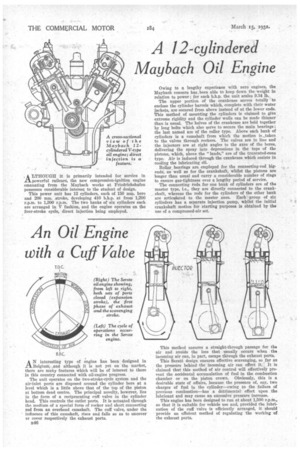A 1 2-cylindered Maybach Oil Engine
Page 64

If you've noticed an error in this article please click here to report it so we can fix it.
A LTEIOUGH it is primarily intended for service in ilpowerful railcars, the new compression-ignition engine emanating from the Maybach works at Friedrichshafen possesses considerable interest to the student of design. This power unit has 12 cylinders, each of 150 mm. bore and 200 mm. stroke, developing 410 b.h.p. at from 1,200 r.p.m. to 1,300 r.p.m. The two banks of six cylinders each are arranged in V fashion, and the engine operates on the four-stroke cycle, direct injection being employed. Owing to a lengthy experience with aero engines, the Maybach concern has.been able to keep down the weight in relation to power; for each b.b.p. the unit scales 9.34 lb.
The upper portion of the crankcase serves totally to enclose the cylinder barrels which, complete with their water jackets, are secured from above instead of at the lower ends. This method of mounting the cylinders is claimed to give extreme rigidity and the cylinder walls can be made thinner than is usual. The halves of the crankcase are held together by long bolts which also serve to secure the main bearings ; the last named are of the roller type. Above each bank of cylinders is a camshaft from which the motion is taken to the valves through rockers. The valves are in line and the injectors are at right angles to the axes of the bores, delivering the spray into depressions in the tops of the pistons, which, above the "lands," are of the truncated-cone type. Air is induced through the crankcase which assists in cooling the lubricating oil.
Roller bearings are employed for the connecting-rod bigends, as well as for the crankshaft, whilst the pistons are longer than usual and carry a considerable number of rings to ensure gas-tightness over a lengthy period of service.
The connecting rods for one bank of cylinders are of the master type, i.e., they are directly connected to the crankshaft, whereas the rods for the cylinders of the other bank are articulated to the master ones. Each group of six cylinders has a separate injection pump, whilst the initial crankshaft motion for starting purposes is obtained by the use of a compressed-air set.




































































































